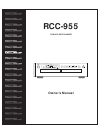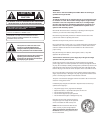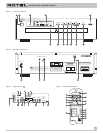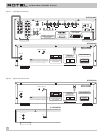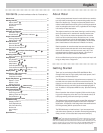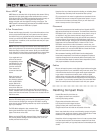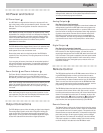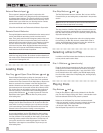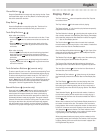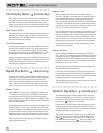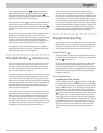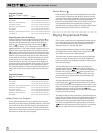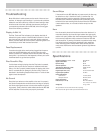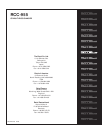
7
English
AC Power and Control
AC Power Input
16
Your RCC-955 is configured at the factory for the proper AC volt-
age in the country where you purchased it (either 115 volts or 230/
240 volts. The AC line configuration is noted on a decal on the
back panel.
Note: Should you move your CD player to another country, it may
be possible to re-configure it for use on a different line voltage. Do
not attempt to perform this conversion yourself. Opening the en-
closure of the RCC-955 exposes you to dangerous voltages. Con-
sult a qualified service person or the Rotel factory service
department for information.
The RCC-955 should be plugged directly into a 2-pin polarized wall
outlet or into the switched outlet on another component in your
audio system. Do not use an extension cord.
Be sure the power switch on the front panel of the RCC-955 is
turned off (in the "out" position). Then plug the power cord into an
AC power outlet.
If you are going to be away from home for an extended period of
time such as a month-long vacation, it is a sensible precaution to
unplug your CD player (as well as other audio and video compo-
nents) while you are away.
Power Switch
1
and Power Indicator
2
The Power Switch is located on the left side of the front panel.
Push the switch button in to turn on the RCC-955. To turn the
RCC-955 off, push the button again to return it to the "out" position.
Note: If you are using a switched outlet to turn on and off your CD
player, you should leave the power switch in the "on" position.
When AC power is applied to the unit, it will power up in fully ac-
tive mode.
When the Power Switch is turned on the disc in position 1 in the
tray is selected. The Disc and Track Displays illuminate and show
Disc 1/ Track 1. The Time Indicator also illuminates.
Output Connections
The RCC-955 gives you a choice of analog or digital output signals.
The analog output signal from the built-in Digital to Analog con-
verter is used with conventional analog audio components. The
digital output, which provides an unprocessed digital data signal,
is used with outboard D/A converters or digital processors.
Note: To prevent loud noises that neither you nor your speakers
will appreciate, make sure all the system components are turned
off when you make any signal connections.
Analog Outputs
13
[See Figure 5 for wiring illustration]
A pair of standard RCA jacks supplies a conventional unbalanced
analog output signal from the RCC-955 to the source inputs of an
audio preamplifier, integrated amplifier, or receiver. RCA connec-
tions are found on virtually all components. Select high quality au-
dio interconnect cables. Connect the left channel output of the
RCC-955 to the left channel source input on the preamplifier or
other component. Connect the right output of the RCC-955 to the
right channel source input on the preamplifier or other compo-
nent.
Digital Output
15
[See Figure 6 for connection illustration]
If you are using the RCC-955 as a disc transport with an outboard
D/A converter or other digital processor, you need an unproc-
essed digital data stream from the RCC-955, taken before the built-
in D/A converter. This signal is supplied by the back-panel coaxial
digital output jack. Using a standard 75 ohm coax cable, connect
the digital output jack to the digital input connector on the out-
board D/A converter.
Remote Control
The RCC-955 is supplied with an RR-D92 remote control. When us-
ing the RR-D92 the emitter on the front of the control must be
pointed at the RCC-955 front panel. The basic disc play functions
are controlled by the button located near the front of the RR-D92.
There is a cover over the lower portion of the RR-D92 that slides
down to reveal buttons that control secondary functions, such as
programming, disc scanning and direct disc selection.
The RR-D92 duplicates the basic disc play control functions of the
front panel control buttons. When a disc play control is on both
the front panel and the remote control, both control identifiers are
shown in the related instruction text. For example, to play a disc
you can press either
7
on the front panel or
19
on the remote
control. There are some functions, such as programmed track
play functions, that are operated exclusively by the RR-D92.
Remote Sensor
3
The Remote Sensor picks up the infrared signals from the remote
control. Do not cover or block the sensor. It must be unobstructed
or the remote control will not work properly. The operation of the
Remote Sensor can also be affected if it is exposed to bright light,
particularly sunlight. Certain types of lighting, such as halogen
lights, that emit a fair amount of infrared light, can also interfere
with proper operation. In addition remote control functions may
not work reliably if the batteries in the RR-D92 are weak.



